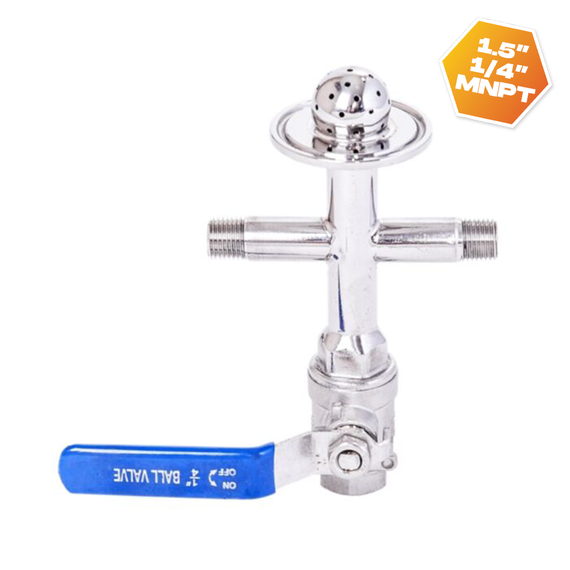

This inlet end cap valve is crafted from durable 304 stainless steel and includes a built-in shower head designed to distribute fluids evenly throughout the material column—helping reduce dry spots and improve column efficiency.
It comes standard with a ¼” female NPT welded ball valve, also made from 304 stainless steel. Please note: a separate fitting is required to connect a hose to the ball valve. If you do not already have one, this fitting can be purchased separately.
Users have the option to attach a pressure gauge to the assembly, allowing for real-time monitoring of pressure within the material column.
This component is designed to operate in conjunction with a recovery tank. The third port is a versatile connection point, typically used either for vacuum evacuation of the material column or for introducing nitrogen into the system from the top.
Enables use of nitrogen assist
Supports vacuuming directly from the material column
In closed-loop systems, nitrogen enables efficient movement of fluids at subzero temperatures—without requiring heat to be applied to the recovery tank. This no-heat approach supports better dewaxing and helps maintain a higher purity of the final extract.
However, nitrogen increases system pressure in cold conditions, so it’s important to bleed the system occasionally. This can be done from the base or the recovery tank.
Vacuuming from the column side is essential for efficient multi-run workflows. It allows you to disconnect and reload the material column while system recovery continues—saving both time and effort without the need to dismantle the entire rig.
After reconnecting the column, you’ll need to vacuum the system again. This cannot be done from the base, as it will often contain residual oil or fluid. Instead, vacuum should be drawn through the hose returning to the recovery tank and the column itself, all the way down to the ball valve that connects to the base.
This step is critical for two reasons:
Safety – Air trapped inside the system can increase risk during operation.
Purity – Any residual air will condense once dry ice is introduced, leading to moisture buildup inside the material column. This can compromise filtration and reduce the clarity of the end product.
This inlet end cap valve is crafted from durable 304 stainless steel and includes a built-in shower head designed to distribute fluids evenly throughout the material column—helping reduce dry spots and improve column efficiency.
It comes standard with a ¼” female NPT welded ball valve, also made from 304 stainless steel. Please note: a separate fitting is required to connect a hose to the ball valve. If you do not already have one, this fitting can be purchased separately.
Users have the option to attach a pressure gauge to the assembly, allowing for real-time monitoring of pressure within the material column.
This component is designed to operate in conjunction with a recovery tank. The third port is a versatile connection point, typically used either for vacuum evacuation of the material column or for introducing nitrogen into the system from the top.
Enables use of nitrogen assist
Supports vacuuming directly from the material column
In closed-loop systems, nitrogen enables efficient movement of fluids at subzero temperatures—without requiring heat to be applied to the recovery tank. This no-heat approach supports better dewaxing and helps maintain a higher purity of the final extract.
However, nitrogen increases system pressure in cold conditions, so it’s important to bleed the system occasionally. This can be done from the base or the recovery tank.
Vacuuming from the column side is essential for efficient multi-run workflows. It allows you to disconnect and reload the material column while system recovery continues—saving both time and effort without the need to dismantle the entire rig.
After reconnecting the column, you’ll need to vacuum the system again. This cannot be done from the base, as it will often contain residual oil or fluid. Instead, vacuum should be drawn through the hose returning to the recovery tank and the column itself, all the way down to the ball valve that connects to the base.
This step is critical for two reasons:
Safety – Air trapped inside the system can increase risk during operation.
Purity – Any residual air will condense once dry ice is introduced, leading to moisture buildup inside the material column. This can compromise filtration and reduce the clarity of the end product.

